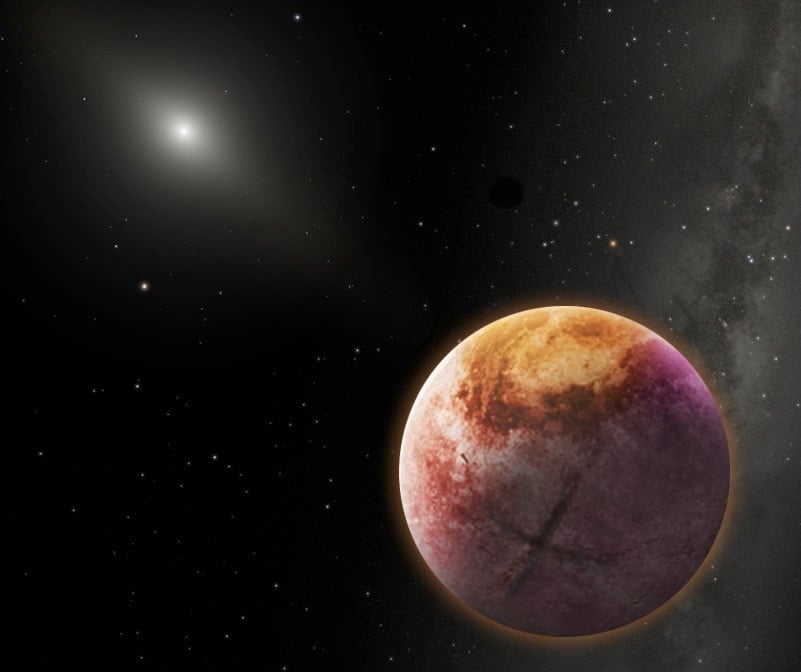In 2014, Scott Sheppard of the Carnegie Institution for Science and Chadwick Trujillo of Northern Arizona University
proposed an interesting idea
. Noting the similarities in the orbits of distant Trans-Neptunian Objects (TNOs), they postulated that a massive object was likely influencing them. This was followed in
2016 by Konstantin Batygin and Michael E. Brown
of Caltech suggesting that an undiscovered planet was the culprit.
Since that time, the hunt has been on for the infamous "Planet 9" in our Solar System. And while no direct evidence has been produced, astronomers believe they are getting closer to discerning its location. In a paper that was recently accepted by
*The Astronomical Journal*
, Sheppard and Trujillo present their latest discoveries, which they claim are further constraining the location of Planet 9.
For the sake of their study, Sheppard and Trujillo relied on information obtained by the Dark Energy Camera on the
Victor Blanco 4-meter telescope
in Chile and the Japanese Hyper Suprime-Camera on the 8-meter
Subaru Telescope
in Hawaii. With the help of David Tholen from the University of Hawaii, they have been conducting the largest deep-sky survey for objects beyond Neptune and the Kuiper Belt.
[caption id="attachment_130540" align="aligncenter" width="580"]
An illustration of the orbits of the new and previously known extremely distant Solar System objects - showing the clustering in orbits that indicates that possible presence of Planet X. Credit: Robin Dienel/Carnegie Science
[/caption]
This survey is intended to find more objects that show the same clustering in their orbits, thus offering greater evidence that a massive planet exists in the outer Solar System. As Sheppard explained in a recent Carnegie
press release
:
Their most recent discovery was a small collection of more extreme objects who's peculiar orbits differ from the extreme and inner Oort cloud objects, in terms of both their eccentricities and semi-major axes. As with discoveries made using other instruments, these appear to indicate the presence of something massive effecting their orbits.
All of these objects have been submitted to the
International Astronomical Union's (IAU) Minor Planet Center
for designation. They include 2014 SR349, an extreme TNO that has similar orbital characteristics as the previously-discovered extreme bodies that led Sheppard and Trujillo to infer the existence of a massive object in the region.
Another is 2014 FE72, an object who's orbit is so extreme that it reaches about 3000 AUs from the Sun in a massively-elongated ellipse - something which can only be explained by the influence of a strong gravitational force beyond our Solar System. And in addition to being the first object observed at such a large distance, it is also the first distant Oort Cloud object found to orbit entirely beyond Neptune.
[caption id="attachment_128211" align="aligncenter" width="580"]
Artist's impression of Planet Nine as an ice giant eclipsing the central Milky Way, with a star-like Sun in the distance. Credit: ESO/Tomruen/nagualdesign
[/caption]
And then there's 2013 FT28, which is similar but also different from the other extreme objects. For instance, 2013 FT28 shows similar clustering in terms of its semi-major axis, eccentricity, inclination, and argument of perihelion angle, but is different when it comes to its longitude of perihelion. This would seem to indicates that this particular clustering trend is less strong among the extreme TNOs.
Beyond the work of Sheppard and Trujillo, nearly 10 percent of the sky has now been explored by astronomers. Relying on the most advanced telescopes, they have revealed that there are several never-before-seen objects that orbit the Sun at extreme distances.
And as more distant objects with unexplained orbital parameters emerge, their interactions seem to fit with the idea of a massive distant planet that could pay a key role in the mechanics of the outer Solar System. However, as Sheppard has indicated, there really isn't enough evidence yet to draw any conclusions.
"Right now we are dealing with very low-number statistics, so we don't really understand what is happening in the outer Solar System," he said. "Greater numbers of extreme trans-Neptunian objects must be found to fully determine the structure of our outer Solar System."
Alas, we don't yet know if Planet 9 is out there, and it will probably be many more years before confirmation can be made. But by looking to the visible objects that present a possible sign of its path, we are slowly getting closer to it. With all the news in exoplanet hunting of late, it is interesting to see that we can still go hunting in our own backyard!
Further Reading: The Astrophysical Journal Letters
 Universe Today
Universe Today
